|
|
||||||||||||||||||||
|
|
|
|
| Thu Dec 4, 2008 - 8:53 AM EST - By Annie Latham | |
|
|
|
|
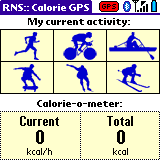
Almost two months ago, I became aware of a little program called Calorie GPS that was designed to leverage readings from a GPS receiver to determine how many calories you burned off doing certain activities. Really? Seemed to me like an interesting concept, so I decided to check it out.
To start, I needed to get a hold of a GPS receiver that I was comfortable carrying with me when exercising. The logical choice was the Freedom Keychain GPS 2000 Bluetooth receiver which is relatively tiny and lightweight (1.81 x 1.26 x 0.58 ins - 0.77oz.).
I loaded the Calorie GPS program onto the memory card of my Centro, though it is only 88K and can easily fit on my Centro.
Getting Calorie GPS to talk to the Keychain GPS was as simple as going to the menu and hitting Options, and GPS Device. The initial discovery was a snap. Plus, I set the program to automatically look for the Keychain GPS each time it is loaded.
Then I went to menu, Options Preferences.
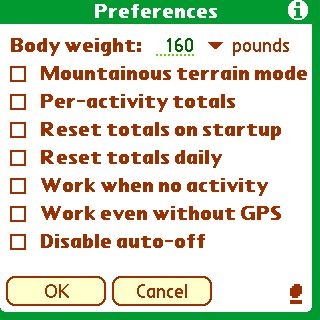
This is where I was able to provide some input to the program before commencing my chosen activity. So I plugged in my body weight and checked off "Per-activity totals" and "Reset totals daily," to start.
On the main screen, I was presented with six activity options represented by images. The runner is for walking/jogging and running. The other options are, bicycling, paddling/rowing, skateboarding, skating/roller skating, and skiing.
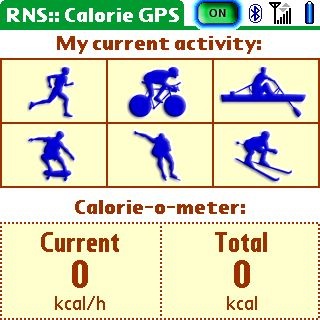
Being that I planned on walking down to the park to hit some of my almostGolf balls, I tapped the first button for walking/jogging/running.
In that same screen, there is what's called a Calorie-o-meter which consists of Current kcal/h (that is kilocalorie per hour) and Total kcal (kilocalorie).
Note: Kilocalorie (symbol: kcal), or Calorie (capital C) is the amount of heat (energy) needed to increase the temperature of one kg of water by 1 �C. Per another resource on the Web, the "calories" counted for dietary reasons are in fact kilocalories, with the "kilo-" prefix omitted.
I guess, based on the defaults I set, it came up with a default of 52 kcal/h as my going rate.
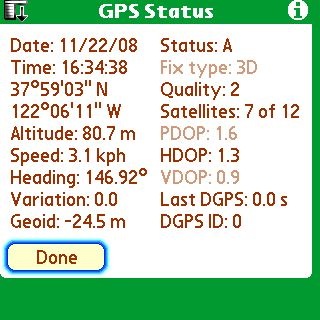
So I walked around for about a half hour, chasing my little golf ball and then got curious. Was the program even talking to my GPS? If so, what kind of information was being relayed?
The date and time were correct. It knew the altitude of where I was and how fast I was going (3.1 kph as in kilometers). It also figured all this out using 7 of 12 satellites.
Anyway, the amount of kcal burned didn't seem to be significant. My conclusion was that urban golf doesn't rate high for weight loss. Still, I felt it was important to check in with the developer of Calorie GPS to get his thoughts.
I emailed Mr. Radoslaw Nowak, who is also a student at Cracow University of Economics in Poland where he is majoring in computer science. He seems to be a Polish entrepreneur following the footsteps of Michael Dell.
AL: What is the basis of the calculation kcal/h and kcal?
RN RNS:: Calorie GPS provides fairly accurate calorie consumption statistics based on the GPS readings and a few user-defined factors. The GPS readings include distance traveled, current velocity, acceleration changes, and can also include altitude changes.
The factors include body weight, terrain characteristics, and activity type. The software processes all these numbers according to the results of a professional scientific analysis, so as to provide the final kcal/h (the number of kilocalories that the user's body consumes in one hour) result to the user. Apart from displaying the real-time calorie consumption, the software sums up all the kilocalories burnt so far, and displays the result in a separate gauge.
AL: How accurate is it? Does it take into account guy/girl, metabolism, etc.?
RN The calculations made by RNS:: Calorie GPS are based on professional scientific analysis performed at the University of South Carolina. The results of the analysis indicate that the amount of calories burnt by a guy or a girl traveling the same distance do not differ much. The only significant factors are body weight (girls usually weigh less than guys, so their bodies burn less calories), distance traveled, and type of activity, which are all taken under consideration by the software for calculations.
AL: I was using it for urban golf. Can it leverage the GPS to do more than just calculate calories?
RN Currently RNS:: Calorie GPS can be used to calculate calorie consumption only. You can however call its "GPS Status" window to see a few other readings received directly from the satellite.
AL: Also, how does it differentiate between jogging and running?
RN One of the factors calculated from the GPS data is the user's velocity while he/she is performing sports activity. This way, running, jogging, as well as walking can be processed in the same way (and thus there is only one activity selection for all of them). The software can also process acceleration changes because your body burns more calories when you stop and accelerate more often, then while you're running steadily.
AL: How was this tested before you released it?
RN We thoroughly tested the software in all modes that it supports, that is: walking, jogging, running, bicycling, paddling, rowing, skateboarding, skating, roller skating, and skiing. Then we compared the results with scientific analysis, as well as with the readings from a medical device that calculates calorie consumption by measuring your heart beats. We were surprised how accurate the software turned out to be! As a result, we decided that no further tests were necessary and released the first version of RNS:: Calorie GPS in June 2008.
After absorbing his responses, I decided to really put it to the test. So I took it with me on a run. It was a fairly short loop (5 miles or so) with rolling hills.
I don't normally carry anything except my keys when I run, so for this test, I wore a vest with pockets. On the one side was the Keychain GPS receiver. On the other side, was my Centro, which I secured with Duct tape so it wouldn't bounce. And off I went!
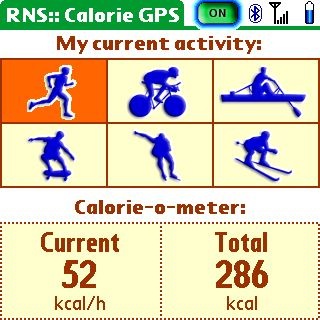
When I got home, I pulled my Centro out of my pocket and learned that my short run was good for 286 kcal burned. Not a lot, but considering I was gone for less than 40 minutes, I can�t complain. A long-neck Coors Light is 110 calories, so technically I could have two and not put on weight, right? Humm... nice rationalization but I better stick to water.
I'll admit that I found CalorieGPS interesting. However, to me, it needs to be packaged with other software to make a complete solution. Anyone embarking on a wellness/fitness program knows that it is a combination of exercise and diet that will gain you results in the long run (pun intended). Calorie GPS is a great start. But I found myself wanting so much more.
You know how those cereal commercials state "part of your nutritious breakfast"? That's the way you should think about Calorie GPS. It does its job well and provides a nice guideline for how your activities impact calories burned. But remember, it is just one of the cornerstones of a proactive health & fitness program.
|
|
||||||||||||||||||||
|
Copyright 1999-2016 TreoCentral. All rights reserved :
Terms of Use : Privacy Policy
TREO and TreoCentral are trademarks or registered trademarks of palm, Inc. in the United States and other countries;
the TreoCentral mark and domain name are used under license from palm, Inc.
The views expressed on this website are solely those of the proprietor, or
contributors to the site, and do not necessarily reflect the views of palm, Inc.
Read Merciful by Casey Adolfsson